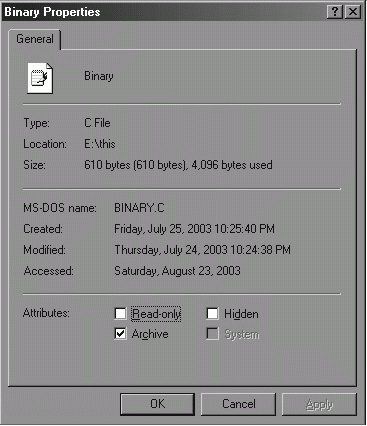The figure given next, shows the properties of a file named BINARY.C and clarifies the fact of the space used by the file in the disk. The actual size of the file is 610 bytes but as the single cluster is of 4,096 bytes, the file uses one cluster (4,096 bytes) in the disk.

A cluster can be made of one or more sectors. It depends on the disk type being used. As a cluster can be made of more than one sector, use of clusters as the allocation unit reduces the size of the File Allocation Table that DOS uses to hold the information of the used and empty disk space.
The cluster size is determined primarily by the size of the disk volume. If not strictly speaking, generally larger volumes use larger cluster sizes. For hard disk volumes, each cluster ranges in size from 4 sectors (2,048 bytes) to 64 sectors (32,768 bytes).
Floppy disks use much smaller clusters, and in some cases use a cluster of size of just 1 sector. The sectors in a cluster are continuous, so each cluster is a continuous block of space on the disk.
The cluster size and thus partition or volume size because they are directly related, has an important impact on performance and disk utilization. The cluster size is determined when the disk volume is partitioned.
There are some utilities like Partition Magic available that can alter the cluster size of an existing partition being within the limits of specific conditions but for the general cases, once the partition size and cluster size is selected it is fixed.
As we have discussed earlier that cylinder or track number starts from 0 and the first sector number is always taken as 1 and one more thing you should remember is that the first cluster number is always taken as 2.
Cluster Size
Clusters are used to allocate the storage area for the data area only. FAT and directory area is not allocated according to the cluster size. On a disk that uses 512-byte sectors, a 512-byte cluster contains one sector, whereas a 4-KB cluster contains 8 sectors.
The following tables list the default cluster sizes used by the DOS for various disks formats. However the size of cluster may be different from the default size in some circumstances:
Floppy Disk Drive (FDD) |
Drive Types |
Sectors/Cluster |
Total Cluster size in bytes (Sectors of 512 bytes Each) |
5.25” 360Kb FDD |
2 sectors |
1,024 |
5.25”1.2Mb FDD |
1 sector |
512 |
3.5” 720Kb FDD |
2 sectors |
1,024 |
3.5”1.44Mb FDD |
1 sector |
512 |
3.5”2.88MB FDD |
2 sectors |
1,024 |
FAT16, FAT32, and NTFS each use different cluster sizes depending on the size of the partition and each file system has a maximum number of clusters it can support. The smaller the cluster size, the more efficiently a disk stores information because unused space within a cluster cannot be used by other files.
The following table shows the default cluster sizes for FAT16 , FAT32 , and NTFS File system partition. FAT 32 allows much more efficient storage and use of larger hard drives, 32 bit FAT is only compatible with Windows 95 OSR-2 and Windows 98/ME and. FAT 16 is supported by MS-DOS, Windows 3.1, Windows 95 and Windows NT. The operating systems Windows 2000/XP use the NTFS file system.
Hard Disk Drive (HDD) |
Partition Size |
FAT16 Cluster Size |
FAT32 Cluster Size |
NTFS Cluster Size |
7 MB–16 MB |
2 KiB |
Not supported |
512 Bytes |
17 MB–32 MB |
512 Bytes |
Not supported |
512 Bytes |
33 MB–64 MB |
1 KiB |
512 Bytes |
512 Bytes |
65 MB–128 MB |
2 KiB |
1 KiB |
512 Bytes |
129 MB–256 MB |
4 KiB |
2 KiB |
512 Bytes |
257 MB–512 MB |
8 KiB |
4 KiB |
512 Bytes |
513 MB–1,024 MB |
16 KiB |
4 KiB |
1 KiB |
1,025 MB–2 GB |
32 KiB |
4 KiB |
2 KiB |
2 GB–4 GB |
64 KiB |
4 KiB |
4 KiB |
4 GB–8 GB |
Not supported |
4 KiB |
4 KiB |
8 GB–16 GB |
Not supported |
8 KiB |
4 KiB |
16 GB–32 GB |
Not supported |
16 KiB |
4 KiB |
32 GB –2 Terabytes |
Not supported |
32 KiB |
4 KiB |
Note :
Here 1 KiB has been written for 1 Binary Kilobyte that means that 1 KiB is of 1024 Bytes or we can say two sectors of 512 Bytes are equivalent of 1KiB.
|


